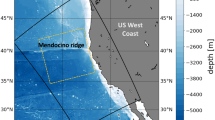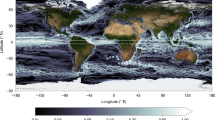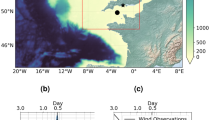Abstract
The persistence in the strength and direction of western boundary great ocean currents suggests that flow-driven turbines implemented in these currents have great potential for energy exploitation. However, technological developments in the design and installation of power-generating plants in the ocean are tied to our capacity to accurately identify the most favourable sites and provide practical assessments of the potentially recoverable energy. Here we use a global eddy-resolving ocean model to demonstrate that large ocean power plants may exert feedback on oceanic circulation that results in highly unpredictable changes in ocean currents. Regionally, these changes can drastically modify the path of the current. In extreme cases this corresponds to a decrease in the available power by more than 80% from initial expectations.
This is a preview of subscription content, access via your institution
Access options
Access Nature and 54 other Nature Portfolio journals
Get Nature+, our best-value online-access subscription
$29.99 / 30 days
cancel any time
Subscribe to this journal
Receive 12 digital issues and online access to articles
$119.00 per year
only $9.92 per issue
Buy this article
- Purchase on Springer Link
- Instant access to full article PDF
Prices may be subject to local taxes which are calculated during checkout







Similar content being viewed by others
Data availability
The current velocity dataset that supports the findings of this study is available at https://doi.org/10.5281/zenodo.3631372. This dataset comprises the five-day zonal and meridional velocity components, from the surface down to 100 m depth, for the regions of the Gulf-Stream and Kuroshio that were considered in this study, for the 1/12° control and turbine simulations used in this study. These components are available in a NetCDF format that contains the appropriate metadata. Documentation that indicates the model coordinates of the points where the drag force was implemented is also provided. Source Data is provided for Figs. 1–7. The five years (2017–2011) of the 1/12° global model outputs of the control experiment and of the 1/36° control and turbine simulations are available only on request because of the large amount of storage space required. Contact: jean-marc.molines@univ-grenoble-alpes.fr.
References
Finkl, C. & Charlier, R. Electrical power generation from ocean currents in the Strait of Florida: some environmental considerations. Renew. Sustain. Energy Rev. 13, 2597–2604 (2009).
Bajah, A. S. Generating electricity from the oceans. Renew. Sustain. Energy Rev. 15, 3399–3416 (2011).
Chen, F., Lu, S.-M., Tseng, K.-T., Lee, S.-C. & Wanga, E. Assessment of renewable energy reserves in Taiwan. Renew. Sustain. Energy Rev. 14, 2511–2528 (2010).
Kabir, A., Lemongo-Tchamba, I. & Fernandez, A. An assessment of available ocean current hydrokinetic energy near the North Carolina shore. Renew. Energy 80, 301–307 (2015).
Akimoto, H., Tanaka, K. & Uzawa, K. A conceptual study of floating axis water current turbine for low-cost energy capturing from river, tide and ocean currents. Renew. Energy 57, 283–288 (2013).
Lee, S. H., Lee, S. H., Jang, K., Lee, J. & Hur, N. A numerical study for the optimal arrangement of ocean current turbine generators in the ocean current power parks. Curr. Appl. Phys. 10, S137–S141 (2010).
Fleming, A. Aquantis C-Plane Ocean Current Turbine Project (Dehlsen Associates and US Department of Energy, 2015).
Chang, Y.-C., Chu, P. C. & Tseng, R.-S. Site selection of ocean current power generation from drifter measurements. Renew. Energy 80, 737–745 (2015).
Yang, X., Haas, K. A. & Fritz, H. M. Evaluating the potential for energy extraction from turbines in the Gulf Stream system. Renew. Energy 72, 12–21 (2014).
Tseng, R.-S., Chang, Y.-C. & Chu, P. C. in Marine Renewable Energy (eds Yang, Z. & Copping, A.) 159–177 (Springer International, 2017).
Hanson, H. P., Skemp, S. H., Alsenas, G. M. & Coley, C. E. Power from the Florida Current: a new perspective on an old vision. Bull. Am. Meteorol. Soc. 91, 861–866 (2010).
Hanson, H. P. Gulf Stream energy resources: North Atlantic flow volume increases create more power. Ocean Eng. 87, 78–83 (2014).
Chen, F. Kuroshio power plant development plan. Renew. Sustain. Energy Rev. 14, 2655–2668 (2010).
Duerr, A. E. S., Dhanak, M. R. & Van Zwieten, J. H. Utilizing the hybrid coordinate ocean model data for the assessment of the Florida’s current hydrokinetic renewable energy resource. Mar. Technol. Soc. J. 12, 24–33 (2012).
Duerr, A. E. S. & Dhanak, M. An assessment of the hydrokinetic energy resource of the Florida current. IEEE J. Ocean. Eng. 37, 281–293 (2012).
Van Zwieten, J. H., Meyer, I. & Alsenas, G. Evaluation of HYCOM as a tool for ocean current energy assessment. In Proceedings of the 2nd Marine Energy Technology Synposium 1–11 (Virginia Tech., 2014).
Yang, X., Haas, K. A. & Fritz, H. M. Theoretical assessment of ocean current energy potential for the Gulf Stream system. Mar. Technol. Soc. J. 47, 101–112 (2013).
San, O. Numerical assessments of ocean energy extraction from western boundary currents using a quasi-geostrophic ocean circulation model. Int. J. Mar. Energy 16, 12–29 (2016).
Haas, K., Yang, X., Neary, V. & Gunawan, B. in Marine Renewable Energy 217–236 (Springer International, 2017).
Li, X. et al. Modelling tidal stream turbines in a three-dimensional wave-current fully coupled oceanographic model. Renew. Energy 114, 297–307 (2017).
Roc, T., Conley, D. C. & Greaves, D. Methodology for tidal turbine representation in ocean circulation model. Renew. Energy 51, 448–464 (2013).
De Dominicis, M., O’Hara Murray, R. & Wolf, J. Multi-scale ocean response to a large tidal stream turbine array. Renew. Energy 114, 1160–1179 (2017).
Hurlburt, H. E., et al. High-resolution global and basin-scale ocean analyses and forecasts. Oceanography 22, 110–127 (2009).
Treguier, A.-M. and the Drakkar group. Developing high resolution ocean components for European Earth System Models. CLIVAR Exchanges 19, 18–21 (2014).
Le Traon, P. Y. et al. The Copernicus Marine Environmental Monitoring Service: main scientific achievements and future prospects. Mercator Ocean J. 56, 2–101 (2017).
Lellouche, J.-M. et al. Evaluation of global monitoring and forecasting systems at Mercator Océan. Ocean Sci. 9, 57–81 (2013). 2013.
Lellouche, J.-M. et al. in New Frontiers in Operational Oceanography (eds Chassignet, E., Pascual, A. et al.) 563–592 (GODAE OceanView, 2018).
Deshayes, J. et al. Oceanic hindcast simulations at high resolution suggest that the Atlantic MOC is bistable. Geophys. Res. Lett. 40, 3069–3073 (2013).
Treguier, A.-M. et al. Meridional transport of salt in the global ocean from an eddy-resolving model. Ocean Sci. 10, 243–255 (2014).
Sérazin, G. et al. Intrinsic variability of sea-level from global 1/12° ocean simulations: spatio-temporal scales. J. Clim. 28, 4279–4292 (2015).
Hewitt, H. T. et al. The impact of resolving the Rossby radius at mid-latitudes in the ocean: results from a high-resolution version of the Met Office GC2 coupled model, Geosci. Model Dev. 9, 3655–3670 (2016).
Akuetevi, C. Q. C., Barnier, B., Verron, J., Molines, J. M. & Lecointre, A. Interactions between the Somali Current eddies during the summer monsoon: insights from a numerical study. Ocean Sci. 12, 185–205 (2016).
Treguier, A.-M., Lique, C., Deshayes, J. & Molines, J.-M. The North Atlantic eddy heat transport and its relation with the vertical tilting of the Gulf Stream axis. J. Phys. Oceanogr. 47, 1281–1289 (2017).
Stewart, K. D. et al. Anisotropy of eddy variability in the global ocean. Ocean Model. 95, 53–65 (2015).
Rieck, J. K., Böning, C. W., Greatbatch, R. J. & Scheinert, M. Seasonal variability of eddy kinetic energy in a global high-resolution ocean model. Geophys. Res. Lett. 42, 9379–9386 (2015).
Patara, L., Böning, C. W. & Biastoch, A. Variability and trends in Southern Ocean eddy activity in 1/12° ocean model simulations. Geophys. Res. Lett. 43, 4517–4523 (2016).
Laurindo, L., Mariano, A. & Lumpkin, R. An improved near-surface velocity climatology for the global ocean from drifter observations. Deep Sea Res. Part I Oceanogr. Res. Pap. 124, 73–92 (2017).
Rio, M.-H. & Etienne, H. For Global Ocean Delayed Mode in situ Observations of Ocean Surface Currents Report No. CMEMS-INS-QUID-013-044, Version 1.2 (Copernicus, 2017); https://doi.org/10.13155/41256.
Scott, R. B. et al. Total kinetic energy in four global eddying ocean circulation models and over 5000 current meter records. Ocean Model. 32, 157–169 (2010).
Hansen, M. O. L. Aerodynamics of Wind Turbines 2nd ed. (Earthscan Publications, 2008).
McGowan J. G., Manwell, J. F. & Rogers, A. L. Wind Energy Explained: Theory, Design and Application (John Wiley and Sons, 2002).
Madec, G. et al. NEMO Ocean Engine Report No. 27 (IPSL, 2016).
Barnier, B. et al. Impact of partial steps and momentum advection schemes in a global circulation model at eddy permitting resolution. Ocean Dyn. 56, 543–567 (2006).
Hanson, H. P., Bozek, A. & Duerr, A. E. S. The Florida Current: a clean but challenging energy resource. Eos 92, 29–36 (2011).
Maraldi, C. et al. NEMO on the shelf: assessment of the Iberia–Biscay–Ireland configuration. Ocean Sci. 9, 745–771 (2013).
Dee, D. P. & Uppala, S. M. The ERA-Interim reanalysis: configuration and performance of the data assimilation system. Q. J. R. Meteorol. Soc. 137, 553–597 (2011).
Shirasawa, K., Kohei Tokunaga, K., Iwashita, H. & Tsumoru Shintake, T. Experimental verification of a floating ocean-current turbine with a single rotor for use in Kuroshio current. Renew. Energy 91, 189–195 (2016).
Acknowledgements
Research leading to these results benefited from support provided by the program Les Enveloppes Fluides et l’Environnemens (LEFE) of Institut des Sciences de l’Univers (INSU), the Partenariat Hubert Curien Kolmogorov (no. 38102RF) and project no. 14.W03.31.0006 of the Russian Ministry of Education and Science. This work benefited from the support given by INSU to the DRAKKAR international coordination network. It was granted access to high performance computing resources under the allocation x2014-010727 attributed by GENCI (Grand Equipement National de Calcul Intensif) to DRAKKAR, with simulations carried out at the supecomputer facility of the Centre Informatique National de l’Enseignement Supérieur (CINES). B.B., J.M.M., T.P., J.L.S., T.M. and P.B. are supported by Centre National de la Recherche Scientifique (CNRS). A.D. and P.C. were supported by Université Grenoble Alpes. S.G. is supported by the Russian Academy of Science. L.B. is supported by Ocean Next. We acknowledge the availability of the ADCP data on the Florida Atlantic University website. We thank our colleagues of the weekly Institut des Géosciences de l’Environnement Friday beer event who fostered our motivation for the study.
Author information
Authors and Affiliations
Contributions
A.D. and B.B. conceived the study. B.B. and S.G. supervised the research. A.D., B.B., S.G. and L.B. produced the figures. J.-M.M. carried out the model simulations and managed the data base. P.C. designed and carried out the 1/36° simulations. A.D., B.B. and S.G. analysed model data, produced the results and wrote the paper. T.M. provided expertise on turbine theory. T.P., J.L.S., P.B., P.C. and L.B. provided expertise in the interpretation of the ocean model sensitivity and contributed to editing the paper.
Corresponding author
Ethics declarations
Competing interests
The authors declare no competing interests.
Additional information
Publisher’s note Springer Nature remains neutral with regard to jurisdictional claims in published maps and institutional affiliations.
Supplementary information
Supplementary Information
Supplementary Figs. 1–12, Tables 1–4, Notes 1–8, refs. 1–5.
Source data
Source Data Fig. 1
Model data (in NetCDF format) used to plot Fig. 1c. The files contain the mean current field for the year 2008 of the control simulation for the Gulf-Stream and the Kuroshio domains. Variables given are depth, longitude, latitude, current direction, current speed and zonal and meridional velocity components, at ten different depths from the surface.
Source Data Fig. 2
The TAP calculated from the control simulation (mean of 2007–2011) for the global ocean (in NetCDF format).
Source Data Fig. 3
Mean TAP and HP values at each of the 16 TPP sites, for the control and turbine experiments and for all other sensitivity experiments. Sheet 1 is for Fig. 3a, and sheet 2 for Fig. 3b.
Source Data Fig. 4
Two NetCDF files containing the mean current field for the year 2008 of the control and of the turbine simulations for the Gulf-Stream domain. Variables given are longitude, latitude and current speed at the depth of 32 m. Barnier_SourceData_Fig4_Control.nc is used for Fig. 4a. Barnier_Sourcedata_Fig4_Turbine.nc is used for Fig. 4b. Figure 4c is the difference of the datasets.
Source Data Fig. 5
The time series of the current speed at site gs7 and the occurrence of the current speed and direction.
Source Data Fig. 6
Same as for Fig. 4, but for the Kuroshio domain.
Source Data Fig. 7
The time series of the TAP and HP at site ks16 and the occurrence distribution.
Rights and permissions
About this article
Cite this article
Barnier, B., Domina, A., Gulev, S. et al. Modelling the impact of flow-driven turbine power plants on great wind-driven ocean currents and the assessment of their energy potential. Nat Energy 5, 240–249 (2020). https://doi.org/10.1038/s41560-020-0580-2
Received:
Accepted:
Published:
Issue Date:
DOI: https://doi.org/10.1038/s41560-020-0580-2
This article is cited by
-
Passive flow control mechanisms with bioinspired flexible blades in cross-flow tidal turbines
Experiments in Fluids (2021)
-
A high-efficiency bioinspired photoelectric-electromechanical integrated nanogenerator
Nature Communications (2020)



